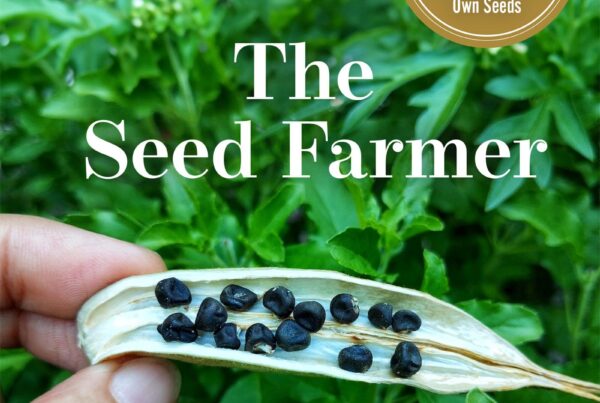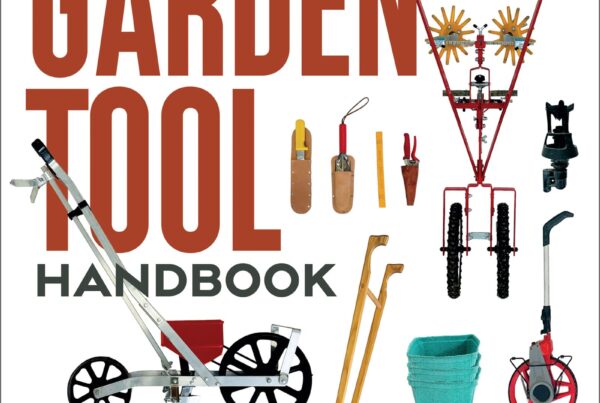Book Review Practical No-Till Farming: A Quick and Dirty Guide to Organic Vegetable and Flower Growing by Andrew Mefferd, New Society Publishers, November 2022, 240 pages, $34.99.
Book Review by Pam Dawling
This is a valuable quick-start guide to small-scale and medium-scale no-till farming, for which many growers will be grateful. Get a tarp, get started and learn as you go, reading this and Andrew Mefferd’s earlier book, Organic No-Till Farming Revolution as needed. Practical No-Till Farming cuts to the chase with a decision-making matrix for choosing the best methods at each transition point, methods that are regenerative, efficient and earn you a living.
Done well, organic no-till growing can produce more for the time you put in, while improving the biodiversity in the soil. Yields can also be higher per area, while weed management is easier and to add to the benefits, you can sequester carbon in the soil at the same time.
WHAT IS NO-TILL?
The author’s definition of no-till includes any method that doesn’t invert the soil profile. There are no-till farmers who go further and avoid growing root crops, because digging them out resembles tillage. Everyone sets their own limits. Andrew encourages all to try reducing tillage, as a step to good care of the soil.
There are many no-till methods, including covering with silage tarps, mulching with cardboard, straw, or compost. And there are many opinions on the best way to get started. Practical No-Till Farming will help you choose the methods best suited to your situation. This book includes how to:
- assess no-till options for your farm, considering soil, climate, and the crops you want to grow;
- balance the pros and cons, and assess the materials and the relative costs of popular no-till methods;
- use a decision-making matrix for choosing good no-till methods at each stage of your journey;
- maximize productivity of no-till production;
- deal with bindweed, symphylans, and other difficult weeds and pests;
- make a task list of what to do and when, for each no-till method;
- learn from Andrew’s experience of organic vegetable and flower no-till market farming.
WHY DO NO-TILL?
The first 70 pages of the book, approximately, are full with the Why of No-Till. The Why is followed by about 130 pages of the How of No-Till, including advantages and disadvantages of tilling and no-till, tarping, mulching, cropping strategies, transitions between crops, and good crops to focus on. You can even skip the Why section and go straight to the How section (although you’ll probably want to come back later).
It has been three years since Andrew’s first no-till book, The Organic No-Till Farming Revolution, and many kinds of no-till are underway, (some for 10,000 years): lasagna gardening, no-dig, and permanent mulch. What’s fairly new is doing this on a farm scale rather than a backyard scale. Chemical no-till farming has taken off in the US, paired with GMO crops that don’t die when sprayed with herbicides. Without tillage, there is less soil erosion, but the runoff water from chemical no-till fields has high levels of herbicides and pesticides, so the environment is far from improved. Many organic, sustainable, regenerative farmers want to use no-till methods without pesticides, herbicides and chemical fertilizers, in order to take better care of the soil and the wider environment.
We take care of the soil biology so it can cycle nutrients to our plants. Soil micro-organisms release nutrients that would otherwise stay locked up in the soil. We can consciously farm these little creatures, ensuring they have conditions where they can thrive and thus make nutrients available to our crops. Tillage kills many soil micro-organisms, especially the larger ones, leaving the soil dominated by bacteria rather than fungi. No-till methods favor the symbiotic relationships in the soil, some of which were only discovered in the past 20 years.
Tillage burns up the organic matter. We then have to add more back to grow crops. Tillage dries out the soil, and we then have to irrigate. No-till is less wasteful, more regenerative and more profitable. This book explores the advantages of no-till in a reader-friendly informative way.
No-till farming is particularly valuable to new farmers as it does not require large pieces of land or large equipment (aka lots of money). One person with access (not even ownership) to one acre (0.4 hectare) of land, and hand tools and tarps can start a small farm with very little else, and make a living. No-till enables farming on land otherwise unsuitable: too steep, too small, an awkward shape. Also on land with contaminated soil – grow flowers, or grow food crops in containers on a tarp over the soil.
No-till gives you more flexibility about when fields are prepped and planted. Tarping allows beds to be “saved” for later. In an urgent situation, use tarps slow down the descent into chaos that can overcome a beginner farmer or one whose life has taken an unexpected turn.
Andrew is upfront about the disadvantages of no-till: soils are slower to warm up in spring, and slower to provide nutrients to very early crops; the first year or two may be difficult, as the weed pressure takes time to reduce. Some methods are hard to scale up (think about acres of tarps). Some pests flourish in high-residue fields. Field-scale no-till methods tend to suppress weeds but not eliminate them. Perennial weeds can become a bigger problem as years go by, and you’ll have no mechanical way to eliminate them.
HOW TO DO NO-TILL
Some no-till methods require patience. You could tarp a piece of land in grass in the fall, and leave the tarp in place until spring, to plant annual crops. Tarping works by smothering plants and depriving them of light. If the soil is damp when tarped, weed seeds can germinate, but will then die due to lack of light. Tarping or heavy mulching do take longer to kill weeds, but passively: during that time you can do other tasks.
To succeed in feeding the soil, make sure the soil contains something to digest the weeds or crop debris – the soil microbiome. Take care of the micro-livestock, and they will convert the nutrients into forms the future crops can use.
Sometimes preparation for no-till involves tilling (one last time). “You can’t grow a carrot in a lawn.” Tillage is a reset button for turning pasture or a lawn into arable land. Likely you will need to make a trade-off between using your ideal no-till method, and earning some money from your farming sooner than the year it could take to tarp the sod to death.
Some no-till methods are more suited to large areas. One example is the roller-crimper method of terminating cover crops with a crimping roller to form a mulch in place, into which the new crop is transplanted. There are special no-till drills that can plant seed into a fairly thick killed cover crop residue. These are large machines. Not all no-till growers can (or want to) plant large areas with large machines.
On a small scale, transplanting into mow-killed or roll-killed cover crops works much better than direct seeding. Likewise, transplants are easier in the looser soil of a no-till system with raised beds, where you remove the old crop, add needed compost and amendments on top, and plant the new crop. Transplants can root in rougher soil than a seed can germinate in. If seeding, the bigger the seed, the easier the task. You might be surprised to learn that most crops can be transplanted, including sweet corn, watermelon, winter squash, peas and beans. Another advantage of using transplants is that you have living roots in the soil for a higher proportion of the time, compared with direct seeding. Another is the gain of effective growing season: you may be able to grow two or three crops in sequence, because each is in the ground for several weeks less than when you direct-sow. Sometimes transplanting the crop will be easier than making a fluffy seedbed to drill into. Transplanting one-cut lettuce rather than sowing baby salad mix, is an example of changing techniques to fit the no-till paradigm.
Compacted soil can present a challenge in no-till systems. Test by pushing a wire flag into the oil. Use a broadfork to loosen the compacted soil without turning it. Instructions and photos are in the Getting Started chapter.
To use the tarping method, first do soil tests and a test of your compost. Amend your soil as needed, let your compost mature longer if that’s what the tests indicate. Then reduce the height of whatever is growing on the land, as much as possible, by mowing or grazing. If you want the plants to rot away, be sure to run irrigation under the tarp. Dry soil will not rot plants. Cutting the plant matter into small pieces before tarping (with a weed whip or flail mower) will speed up decomposition.
Next, reduce the weed seed bank, by a process called “stale seed-bedding” where you prepare the bed ahead of time, deliberately germinate the weed seeds, then kill the weeds before the crop is planted. Tarping, (provided you leave the tarp down long enough, at least 4 weeks) can germinate and kill the newly emerging weeds.
If that doesn’t happen, you will need to manage the weeds another way. Flame-weeding of tiny weeds provides a clean seedbed. If you miss the white-thread stage of weeds, use a wire weeder, stirrup hoe (scuffle hoe), or a fine-tined weeder to kill small weeds in an existing crop, without inverting any soil. “Blind cultivation” is a method of cultivation after sowing the crop, pulling flexible fine tines shallowly (and fairly quickly) over the surface, killing white-thread-stage weeds. Blind cultivation tools were previously only available as tractor implements, but they are now also made in a manual version. You could instead, lay thick organic mulch, or a sheeting mulch over the soil. There are photos of these tools in action in the book.
Solarization in sunny weather with temperatures above 65°F (18°C), will kill existing weeds in just a couple of days. Solarization involves installing clear hoophouse plastic (UV-inhibited) in close contact with the soil, with the edges firmly held down to trap heat. There is a whole chapter on tarping (aka occultation) and solarization, with everything you need to know to start using these techniques. For small weeds, solarizing is quicker than tarping. Weed seeds and roots of perennial weeds will not die as fast as small weeds.
Mulches are inert materials put on top of the soil to keep weeds and moisture in, to keep light and weed seeds out, or both. The term includes tarps, clear plastic, landscape fabric, plastic mulch, cardboard, paper, straw, tree leaves, woodchips, thick layers of compost, and more. Organic mulches cool the soil (for better or worse), and can attract and harbor some pests (voles, slugs).
Mulch can be grown in place, then mowed or rolled at the right stage, to kill the cover crop. Cover crops start to decompose as soon as terminated, so don’t do it ahead of time. When cover crops start to decompose, weeds start to germinate. You need to plan the timing for this system to work well: when to sow the cover crop, when to terminate, when to transplant the food crop. You need a dense cover crop planting. This system doesn’t fit with frequent plantings of small amounts of crop, but can work well for larger areas of warm-weather transplanted crops. You may have to hand-pull weeds that do come up. If your scale is too small for a tractor-mounted crimping roller, you can try the small-scale method involving two people stepping on a T-post laid across the bed. You can tarp after crimping or mowing. Keeping the cover crop dry delays decomposition.
Winter-killed cover crops provide another opportunity to transplant into mulch grown in place. This only works in early spring, and will keep the soil cooler, and the soil nutrients less available than in bare soil. Be warned – this can delay and reduce harvests of early spring crops.
There is a useful chart summarizing the turning points in a season where a decision needs to be made between one management decision or another. The beginning of season: are there few or many weeds? Time to prep beds: will you be sowing or transplanting? Time to deal with weeds: do you have mulch or not? At the end of the crop: do you have low or high crop residue? At the end of the season: will you use tarps or cover crops?
The best crops to focus on are ones that are in demand, and ones that bring a high price. If space is short, don’t grow sweet corn! One-cut lettuce, with all-small leaves can be a good no-till alternative to baby lettuce mix. Harvest and replant from plugs. You can earn more money, because of the higher yield. Harvest each new planting 30 days later (longer in midwinter). This method keeps living roots in the soil all the time. (unlike baby salad mix). One-cut lettuce has a longer shelf life and fewer brown edges than cut leaves. The seed does cost more, and you need a propagation greenhouse to grow the transplants. For many growers the disadvantages are much fewer than the advantages.
Quick crops lead to multiple crop transitions, and no-till methods make transitions quicker. Cut the old crop (and weeds) off at the soil line, add compost and amendments, and replant. Or tarp the bed, weeds and all, and replant when the residues have died. Flail mowing the residues will speed up the decomposition, whether you are tarping or not.
Andrew includes a case study growing hemp in a quarter-acre (0.1 hectare) field that had not been used for two years, and had partly returned itself to grass. He limed first, then tarped for the month of May, using a cobbled-together mix of some clear greenhouse plastic and some opaque tarps. The weather was cool and rainy (not ideal). The tarps were removed in mid-June. Not much vegetation had survived. Andrew did a soil test, added fertilizer and 4” (10 cm) of compost, then unrolled hay on 5’ (1.5 m) centers, leaving 1’ (30 cm) unmulched in center of each bed, where the plants would go. He transplanted 4” (10 cm) seedlings, and one month later, the weeds were as tall as the crop. He spent eight hours hand-weeding, and two hours with a weed whip. The plants grew to 6-7’ (2 m) by the end of the season, and had closed the canopy, preventing any more weeds from growing. No time was saved compared to tillage method! But the weed seed bank was reduced, and the soil life was conserved, and carbon was sequestered in the soil Definitely successful!
The book finishes up with an appendix, glossary, notes, citations, bibliography, and index. A valuable resource for all of us aspiring to do less tillage, and especially for those hoping to eliminate tillage altogether.







